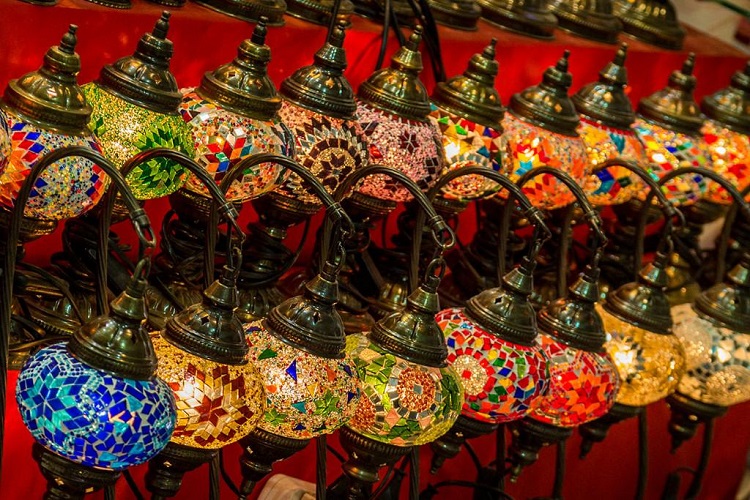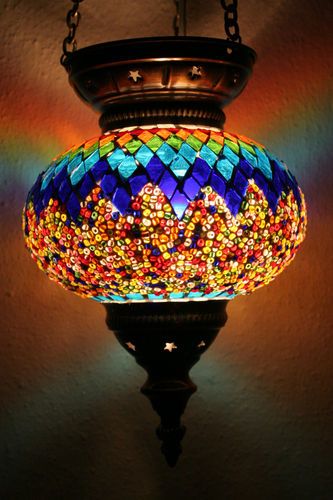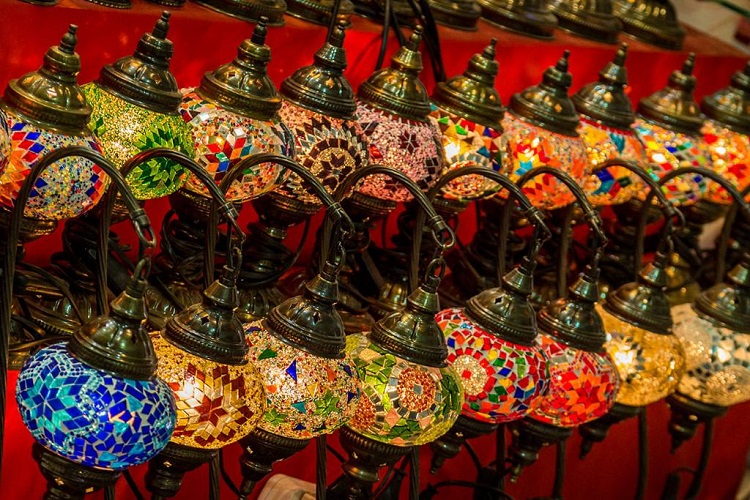THE CAREFUL CRAFTING OF TURKISH MOSAIC LAMPS HOW ITS MADE AND CULTURAL HISTORY
Turkish mosaic lamps are a treasure from the Near East that have finally found an audience here in the West. The mosaic lamp owes its lineage to the Turkish glass making tradition which stretches back for a millennia in Asia Minor. Over the centuries the local glass blowers produced a variety of objects including bowls, flasks, carafes and more that displayed a peerless quality and level of sophistication found in glass products virtually nowhere else in the world. It is likely that the mosaic lamp of today owes a direct historical debt to the local oil lamps of some 500 years ago. In this post we’ll take a quick look at how these incredible art objects are made in the workshops of Turkey and then take a look at the cultural history.

The Making of Turkish Mosaic Lamps
Mosaic lamps derive their beauty from the quality of materials used in their construction and the skill and imagination of the artisans that conceive and fabricate them. Mechanization has virtually no place in the production process and as such each mosaic lamp is very much an individual object d’art. But just what is the production process for such a unique and timeless piece of home decor? While there are aspects of production that must remain between the master craftsman and apprentice the general process is as follows:
- Individual sections are hand cut from larger sheets of handmade glass of different colors and thickness. The size and shape of each specific piece will later play an integral part in the overall design of the various lamp styles.
- A base of clear, hand blown glass is then prepared to accept the individual pieces of cut glass. The basics of the design are laid out on the clear glass using markers to ensure the final pattern adheres to the designer’s original plan.
- A clear, permanent but slow drying adhesive is applied to a small section of the base with the pattern visible through the adhesive to guide the hand of the artisan. Each pattern leaves enough ‘wiggle room’ to allow each lamp to acquire its own expressive characteristics.
- Section by section adhesive is applied and individual glass pieces assembled into the final mosaic form. Once all the pieces are in place a special paste is used to fill the space between individual pieces. The completed lampshade is then given several days to set up properly.
- Once the adhesive and bonding paste has dried special cleaning solutions are applied and rubbed in vigorously to remove any excess bonding paste from the surface of the glass segments. This is a labor intensive effort that may require several passes.
- Following the removal of excess paste the mosaic lamp shade then has any sharp or extruding glass edges smoothed out by use of a wire wheel attached to a mechanical lathe. It is virtually the only aspect of production which utilizes machinery.
- Once the mosaic lamp shade is deemed finished it is attached to brass or bronze components that are fabricated and assembled by hand to form a complete pendant lamp, wall sconce or table lamp that will provide beauty and elegance to your home for generations.
While the chemical composition of the adhesive, bonding paste and cleaning solutions has changed over time, and where the artisans now use markers where once they used ink applied via a brush, the rest of the process is essentially the same as it has been for centuries. None of the updated aspects of the process in any way change the beauty and timelessness of the final product.
The Role of the Mosaic Lamp
Today as you amble through the wealth of Turkish crafts in the Grand Bazaar the glass mosaic lamps you’ll see are little changed from the mosaic lamps that inspired Louis Comfort Tiffany to adapt the idea to his brand of light fixtures. The warmth and honesty exuded by these decorative lamps is not intended to provide bright light for the conduct of detailed work. There are other types of light for that. Their job instead is to set a mood and create a calm, relaxed atmosphere whether you place them in the vestibule or over the kitchen countertop.
Add the Charm, Elegance and Mystery of the Orient to your Home
The Turkish mosaic lamps we sell at Paykoc Imports come in a variety of styles and sizes. Each one is an individual expression of the glass maker’s craft, hand-wired and assembled in workshops that are little changed from the days of the Ottoman Empire and Byzantium before it. There are no mechanized factories in Turkey where mosaic lamps are assembled by robots for mass consumption. These art objects are reminders of timeless traditions and the value of craftsmanship. Long after even the most sophisticated smartphones of today are obsolete these mosaic lamps will remain; silent reminders of the eternal and enduring values of Turkish crafts.
TURKISH MOSAIC LAMPS: TIMELESS BEAUTY, UNMATCHED QUALITY
Glass making as a valued profession goes back hundreds of years in Turkey and is thought by most historians to have reached its zenith in the 16th century. Glass products of this time including flower vases, carafes, drinking glasses, sugar bowls, flasks and more exhibit an amazing delicacy and are examples of the highly developed aesthetic sensibilities of the artisans of the time. It is actually during this time that the historical record first takes note of oil lamps with colorful glass shades that would become the precursors of the Turkish lamps we know today.
Cultural Confusion
The Turkish glass lamp shade spent several centuries being refined and reworked and having its aesthetic breadth expanded and elaborated upon. By the late 19th century it had reached an extraordinary level of elegance and sophistication. It was at this time that Louis Comfort Tiffany, on one of his many European sojourns, first encountered them. He was so taken aback with what he’d found in Constantinople (present day Istanbul) that he returned to his American workshops and set about to try and emulate it.
Tiffany made subtle changes to the production process and also tweaked the look of the glass itself to set them apart from their Byzantine progenitors then launched the new product in 1893 to a rapturous reception from consumers on both sides of the Atlantic. From that point on the mosaic table lamp, which had been developed and refined in Asia Minor for hundreds of years, became widely known as the ‘Tiffany Lamp”.
Turkish Lamps for the Connoisseur
While true Tiffany lamps from the ‘golden age’ of LC Tiffany have long been much sought after collector’s items in recent years a similar interest has arisen in the collecting of antique Turkish mosaic lamps. While these lamps never experienced a decline in build quality or appearance ala Tiffany lamps many people today would nonetheless like to find a genuine antique Turkish mosaic lamp for their home but lack guidelines for distinguishing a genuine antique from a new lamp. If you are one of those people here are a few things you can look for that will help you separate a classic mosaic lamp from its high-quality descendant manufactured recently.

- Hairline cracks - Over time the glass in a mosaic lamp expands and contracts as the temperature rises and falls. As a result it’s not uncommon for an antique mosaic lamp to have small hairline fractures in its glass segments caused by the stress of repeated expansion and contraction. If you don’t see any hairline cracks you’re probably looking at a new-ish lamp.
- Glass color - While the aesthetics behind the Turkish mosaic lamp haven’t changed much in the past century the glass in new lamps will sometimes appear richer and darker in color than it is in lamps that have been used regularly for decades.
- Weight - While today’s Turkish mosaic lamp is made of the same high quality materials they have been for many years there’s no denying that lamps made several decades ago were often ‘overbuilt’. In time production refinements removed most of these excess materials and the result is that newer lamps are often lighter than older ones.
- Defects in the metal - The metal base of an older lamp will typically have small scratches and perhaps even a ding or dent from years of use. These won’t affect the way the light works and many people actually think they add character to the lamp.
Turkish Mosaic Table and Hanging Lamps at Paykoc
The mosaic lamp has evolved over time to become a nearly indispensable addition to any sophisticated décor. The warmth and charm they bring to a space, combined with the tactile quality of their construction and the sheer beauty of the light they cast makes them the perfect anchoring element in the study, the foyer, the kitchen and elsewhere. Few other decorative components will exude such an influence over the way your home is experienced, and fewer still will be capable of doing so for decades to come.
For those looking for newly minted Turkish mosaic lamps Paykoc Imports has a dizzying selection. Whether table lamps or hanging lamps all our lamps are of the same high quality and are every bit the equal of (and more often than not superior to) anything produced today with the name “Tiffany” attached. What’s more is that you won’t be paying the (largely unjustified) premium the Tiffany name brings to their product. Instead you’ll pay a fair price for a beautifully crafted mosaic lamp built by dedicated craftsmen in the one corner of the world where handcrafted quality still matters. Take your time and browse through our online selection or stop by our Denver showroom to see these dazzling Turkish lights in person.
For more information on how to add your mosaic lamp into your home check out our integration guide

 Default Currency
Default Currency
